 |

 |
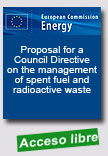 |
Proposal for a Council Directive on the management of spent fuel and radioactive waste
European Commission, November 3rd 2010, 23 p.
Member States are asked to present national programmes, indicating when, where and how they will construct and manage final repositories aimed at guaranteeing the highest safety standards. With the Directive internationally agreed safety standards become legally binding and enforceable in the European Union.
Radioactive waste is not only produced in those states that use
|
nuclear for electricity generation, but also by many other applications, be it radiotherapies or industrial tests. Its safe management is therefore a challenge for all Member States, irrespective of their stance on nuclear.
While low and medium level radioactive waste is increasingly being taken care of, there is not yet a single final repository for high-level radioactive waste and spent fuel. It is likely, however, that the first such repositories will be opened between 2020 and 2025 in several EU Member States.
It is necessary that now all Member States deal with radioactive waste in a responsible and transparent manner and establish national frameworks and programs for the management of all types of radioactive waste and spent fuel. The generations benefiting from nuclear power and applications of radioactive materials should also take care of the waste and the financing thereof.
Extraído de:
http://ec.europa.eu/energy/nuclear/
waste_management/waste_management_en.htm
|
 |
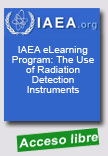 |
IAEA eLearning Program: The Use of Radiation Detection Instruments
IAEA, 2010, s. p.
This radiation detection technique traing includes the following modules: Introduction to the Computer Based Training Programme; Radiation Overview; Introduction to Radiation Detection Equipment; Main Operations of Radiation Detection Equipment; Verification of Alarms and Confirmation of Incidents; Scenario 1; Scenario 2; Assessment. |
Extraído de:
http://www-pub.iaea.org/MTCD/publications/PDF/EPR-FR-eLearning/main.ht
|
 |
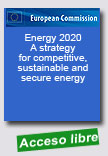 |
Energy 2020 - A strategy for competitive, sustainable and secure energy
European Commission, November 2010, 91 p.
The Communication defines defines the energy priorities for the next ten years and sets the actions to be taken in order to tackle the challenges of saving energy, achieving a market with competitive prizes and secure supplies, boosting technological leadership, and effectively negotiate with our international partners |
Extraído de:
http://ec.europa.eu/energy/strategies/2010/2020_en.htm
|
 |
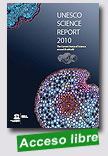 |
The UNESCO Science Report 2010 (USR) was launched on World Science Day on 10 November 2010. The report is a global overview of the main developments in scientific research, innovation and higher education since its predecessor was published in 2005. It blends facts and figures with an analysis of the major trends in global expenditure on research and development, scientific personnel and scientific publications.
Executive summary | Full report |
Extraído de:
http://www.unesco.org/new/en/natural-sciences
|
 |
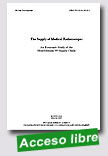 |
The Supply of Medical Radioisotopes - An Economic Study of the Molybdenum-99 Supply Chain
Nuclear Energy Agency (NEA), 16 Sep. 10, 128 p.
The reliable supply of molybdenum-99 (Mo-99) and its decay product, technetium-99m (Tc-99m), is a vital component of modern medical diagnostic practices. Disruptions in the supply chain of these radioisotopes – which cannot be effectively stored – can suspend important medical testing services. Unfortunately, supply reliability has declined over the past decade, due to unexpected or extended shutdowns at the few
|
ageing, Mo-99 producing, research reactors and processing facilities. These shutdowns have created global supply shortages.
This study offers a unique analysis of the economic structure and present state of the Mo-99/Tc-99m supply chain. It finds that the shortages are a symptom of a longer-term problem linked to insufficient capital investment, which has been brought about by an economic structure that does not provide sufficient remuneration for producing Mo-99 or support for developing additional production and processing infrastructure. To assist governments and other decision makers in their efforts to ensure long-term, reliable supply of these important medical isotopes, the study presents options for creating a sustainable economic structure. The study will also enhance understanding amongst stakeholders of the costs of supplying Mo-99 and ultimately contribute to a better functioning market.
Extraído de:
http://www.nea.fr/pub/ret.cgi?id=new#6969
|
 |
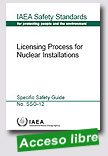 |
Licensing Process for Nuclear Installations Safety Guide
IAEA, 2010, 80 p.
The purpose of this Safety Guide is to provide: (a) Recommendations on developing the basis of a licensing process to be applied by regulatory bodies for granting licences for nuclear installations and their activities, including some aspects of regulatory control; (b) As much information as is practicable on the topics and documents that should be considered in the licensing process throughout the lifetime of the nuclear installation, irrespective of the number of licensing steps or hold points imposed on the licensee.
|
Extraído de:
http://www-pub.iaea.org/MTCD/publications/PDF/Pub1468_web.pdf
|
 |
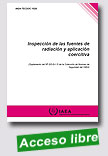
|
Inspección de las fuentes de radiación y aplicación coercitiva
(Suplemento del Nº GS-G-1.5 de la Colección de Normas de Seguridad del OIEA)
IAEA TECDOC Series, 2010, 150 p.
La publicación sobre Requisitos de Seguridad titulada Infraestructura legal y estatal para la seguridad nuclear, radiológica, de los desechos radiactivos y del transporte establece los requisitos de la infraestructura legal y estatal. La palabra ‘infraestructura’ se refiere a la estructura subyacente de sistemas y organizaciones, de la que forman parte los requisitos relativos a la creación de un órgano regulador de las
|
fuentes de radiación y las responsabilidades y funciones que se le asignen.
Las Normas básicas internacionales de seguridad para la protección contra la radiación ionizante y para la seguridad de las fuentes de radiación (las Normas básicas de seguridad, o NBS) establecen unos requisitos básicos para la protección contra los riesgos inherentes a la exposición a la radiación ionizante y para la seguridad de las fuentes de radiación. La aplicación de las NBS se basa en el supuesto de que existen infraestructuras nacionales para que los gobiernos desempeñen sus responsabilidades en lo relativo a la protección y la
seguridad radiológicas.
Este TECDOC proporciona orientaciones prácticas sobre los procesos para efectuar
inspecciones reglamentarias y adoptar medidas coercitivas. Recoge información sobre la elaboración y el empleo de procedimientos y planes de examen estándar (es decir, listas de control) con fines de inspección. En los Apéndices figuran procedimientos específicos para la inspección de prácticas y fuentes de radiación.
Extraído de: http://www-pub.iaea.org/MTCD/publications/PDF/TE_1526_s_web.pd
|
 |
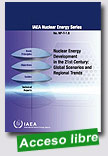 |
Nuclear Energy Development in the 21st Century: Global Scenarios and Regional Trends
IAEA, 2010, 95 p.
Programme Area B of INPRO, Global Vision — Scenarios and Pathways to Sustainable Nuclear
Development, is aimed at providing a better understanding of the role of nuclear energy in the context of long term sustainable development. Its objective is to develop global and regional nuclear energy scenarios on the basis of a scientific-technical pathway analysis, that lead to a global vision on sustainable nuclear energy development in the twenty-first century, and to
|
support Member States in working towards that vision.
In the framework of Programme Area B in INPRO, a study was carried out on Nuclear Energy Development in the 21st Century: Global Scenarios and Regional Trends Studies on Nuclear Capacity Growth and Material Flow between Regions with the following objectives: To illustrate, using idealized examples, the potential contributions of innovative nuclear energy systems using fast reactors and closed fuel cycles to meet global and regional demands for nuclear energy. This is done for a range of possible demand scenarios; To illustrate the potential roles of different reactor types operating in combination in an evolving and growing
global nuclear energy system; To illustrate, for a range of possible demand scenarios, how nuclear material might flow between different regions of the world in the twenty-first century; To identify some of the issues that might need to be addressed to implement the deployment of nuclear energy as presented in the study, in particular, for the two higher demand scenarios.
Extraído de:
http://www-pub.iaea.org/MTCD/publications/PDF/Pub1476_web.pdf
|
 |
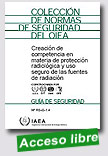 |
Creación de competencia en materia de protección radiológica y uso seguro de las fuentes de radiación
OIEA Colección de normas de seguridad, 2010, 39 p.
La presente guía de seguridad contiene recomendaciones acerca de la manera de cumplir los requisitos establecidos en las NBS [4] y en las referencias [5] y [6] relativos a la capacitación en protección radiológica y en aspectos de la seguridad nuclear, del transporte y de los desechos radiactivos relacionados con la protección radiológica. Se proporciona a los órganos reguladores nacionales orientación sobre el
|
establecimiento de requisitos mínimos de cualificación en la esfera de la protección y la seguridad para las tecnologías nucleares y tecnologías de las radiaciones conexas. También se proporciona orientación sobre una estrategia nacional para la creación de competencia en esta esfera.
Extraído de: http://www-pub.iaea.org/MTCD/publications/PDF/Pub1108s_web.pdf
|
 |
|
|
|
|
|
|
|
|
|
|
|
